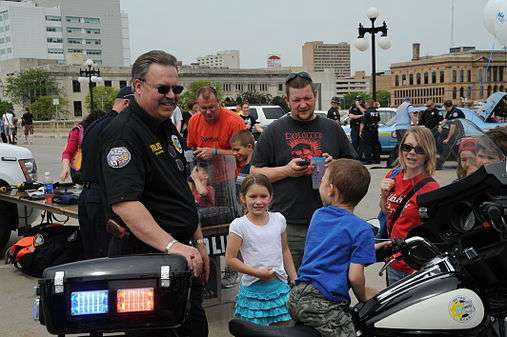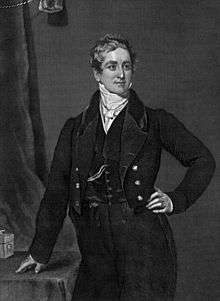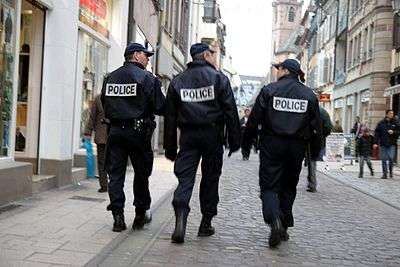Community policing

Community policing, or community-oriented policing, is a strategy of policing that focuses on building ties and working closely with members of the communities. A formal definition states:
"Community policing is a philosophy of full service personalized policing, where the same officer patrols and works in the same area on a permanent basis, from a decentralized place, working in a proactive partnership with citizens to identify and solve problems." —Bertus Ferreira[1]
The central goal of community policing is for the police to build relationships with the community through interactions with local agencies and members of the public, creating partnerships and strategies for reducing crime and disorder.[2][3][4][5][6][7] Although community policing mostly targets low-level crime and disorder, the broken windows theory proposes that this can reduce more serious crime as well.[8]
Common methods of community-policing include:[9]
- Encouraging the community to help prevent crime by providing advice, giving talks at schools, encouraging neighborhood watch groups, and a variety of other techniques.
- Increased use of foot or cycle patrols.
- Increased officer accountability to the communities they are supposed to serve.
- Creating teams of officers to carry out community policing in designated neighborhoods.
- Clear communication between the police and the communities about their objectives and strategies.
- Partnerships with other organizations such as government agencies, community members, nonprofit service providers, private businesses and the media.
- Decentralizing the police authority, allowing more discretion amongst lower-ranking officers, and more initiative expected from them.
Community policing is related to problem-oriented policing and intelligence-led policing and contrasts with reactive policing strategies that were predominant in the late 20th century. It does not eliminate the need for reactive policing, though successful prevention can reduce the need for the latter. Many police forces have teams that focus specifically on community policing, such as Neighbourhood Policing Teams in the United Kingdom, which are separate from the more centralized units that respond to emergencies.
The overall assessment of community-oriented policing is positive, as both officers and community members attest to its effectiveness in reducing crime and raising the sense of security in a community.[10][11]
History


Community policing is often treated as a departure from "traditional policing". However, the ideology behind community policing was first discussed during the birth of modern policing. When Sir Robert Peel founded London's Metropolitan Police in 1829, the nine Peelian Principles were published to outline how it should work. Peel's principles state that the central mission of the police is "to prevent crime and disorder", and that they are an alternative to "repression by military force". They stress that the police need to gain the respect and willing cooperation of the public and warn that use of excessive force is detrimental to this aim. Modern police reformers have described the Peelian Principles as being relevant in the present day, with William Bratton calling them "my bible."[12]
In the early 20th century, the rise of automobiles, telecommunications and suburbanization transformed policing. Police forces moved to using a reactive strategy, focusing on answering to emergency calls as quickly as possible and relying on motor patrols at other times to deter crime.[13] Some police forces such as the Chicago Police Department began rotating officers between different neighborhoods as a measure to prevent corruption.[14] Foot patrols had become rare, and a study by the US-based Police Foundation suggested that this caused the police to became isolated from their communities.[15] The Kansas City preventive patrol experiment provided evidence that aimless motor patrols were not a visible or effective deterrent to crime.[16]
In the United States, the modern movement for community policing began in the 1980s. This came alongside the development of the “Broken Windows” theory, which was introduced by James Q. Wilson and George L. Kelling in 1982. The broken windows theory suggests that low-level crime and disorder in the communities create an environment that encourages more crimes, including serious ones. A small symptom of disorder (such as a broken window) is likely to be ignored by traditional policing, especially if there is no actual crime committed. However, it is an indicator of social disorganization, and therefore requires the attention of the community-oriented officer.
Research by Michigan criminal justice academics and practitioners started being published as early as the 1980s.[17][18] As a Professor of Criminal Justice, Bob Trajanowcz in the late 1990s influenced many future law enforcement leaders on how to implement elements of community policing [19][20] One experiment in Flint, Michigan, involved foot patrol officers be assigned to a specific geographic area to help reduce crime in hot spots.
Community-oriented policing was promoted by the Clinton Administration. The 1994 Violent Crime Control and Law Enforcement Act established the Office of Community Oriented Policing Services (COPS) within the Justice Department and provided funding to promote community policing.
Method
.jpg)
Many community-oriented police structures focus on assigning officers to a specific area called a “beat” and having those officers become familiar with that area or beat through a process of “beat profiling.” The officers are then taught how to design specific patrol strategies to deal with the types of crime that are experienced in that beat.[9]
These ideas are implemented in a multipronged approach using a variety of aspects, such as broadening the duties of the police officer and individualizing the practices to the community they’re policing; refocusing police efforts to face-to-face interactions in smaller patrol areas with an emphasized goal of preventing criminal activity instead of responding to it; solving problems using input from the community they’re policing; and, finally, making an effort to increase service-oriented positive interactions with police.[21]
Comparison with traditional policing
"Traditional policing" is used to describe policing styles that were predominant before modern community policing movements, or in police forces which have not adopted them. The style has also been described as "fire brigade policing" in the UK.[22] In countries with a tradition of policing by consent, the term "traditional policing" can be misleading. In those cases, community policing could be seen as a restoration of an earlier ideology, which had been overshadowed by reactive policing after the rise of automobiles and telecommunications.
The goal of traditional policing is to protect law-abiding citizens from criminals. They do this by identifying and apprehending criminals while gathering enough evidence to convict them. Traditional beat officers' focus on duty is to respond to incidents swiftly, and clear emergency calls. Many officers working busy shifts only have time to respond to and clear emergency calls. This type of policing does not stop or reduce crime significantly; it is simply a temporary fix to a chronic problem.[23]
In contrast, community policing’s main goal is to assist the public in establishing and maintaining a safe, orderly social environment. While apprehending criminals is one important goal of community policing, it is not necessarily the most important goal. Community policing is concerned with solving the crimes that the community is concerned about, and solving concerns by working with and gaining support from the community. The most effective solutions include coordinating police, government resources, citizens, and local business to address the problems affecting the community.[1] They get in touch with the community in a variety of ways, including polls or surveys, town meetings, call-in programs, and meetings with interest groups. They use these connections to understand what the community wants out of its police officers and what the community is willing to do to solve its crime problem.
The structure of the community policing organization differs in that police assets are refocused with the goals of specific, written rules to give more creative problem-solving techniques to the police officer to provide alternatives to traditional law enforcement.[21]
Community alienation
The experience of community alienation among police officers is closely tied to the experience of mastery, the state of mind in which an individual feels autonomous and experiences confidence in his or her ability, skill, and knowledge to control or influence external events.[24] Community policing requires departments to flatten their organizational pyramid and place even more decision-making and discretion in the hands of line officers. As the level of community alienation or isolation that officers experience increases, there will be a corresponding decrease in officers' sense of mastery in carrying out their expanded discretionary role. Second, a strong sense of community integration for police officers would seem to be vital to the core community policing focus of proactive law enforcement. Proactive enforcement is usually defined as the predisposition of police officers to be actively committed to crime prevention, community problem-solving, and a more open, dynamic quality-oriented law enforcement-community partnership.[4][5][25]
A lack of community support resulted in an increased sense of alienation and a greater degree of apathy among police officers.[26][27][28] A lack of community support and working in a larger populated community was associated with an increased sense of alienation and a greater degree of inactivity among police officers.[29] An increased sense of alienation resulted in a greater degree of negative feelings and lethargy among police officers. The more police officers felt socially isolated from the community they served, the more they withdrew and the more negative they felt towards its citizens.[4][30]
Evaluation
Traditionally, determining whether police or policies are effective or not can be done by evaluating the crime rate for a geographic area. A crime rate in the United States is determined using the FBI’s "Uniform Crime Reports" (UCR) or "National Incident-Based Reporting System" (NIBRS) as well as the Bureau of Justice Statistics’ "National Crime Victimization Survey" (NCVS).[31][32]
Community policing is more complicated than simply comparing crime rates and there is no universally-accepted criteria for evaluating community policing. However, there are some structures that are commonly used. One possible way to determine whether or not community policing is effective in an area is for officers and key members of the community to set a specific mission and goals when starting out. Once specific goals are set, participation at every level is essential in obtaining commitment and achieving goals. Street-level officers, supervisors, executives, and the entire community should feel the goals represent what they want their police department to accomplish.[9]
The U.S. federal government continues to provide support for incorporating community policing into local law enforcement practices through funding of research such as through the National Center for Community Policing at Michigan State University,[33] small COPS grants to local agencies, and technical assistance.[34]
The Center For Evidence-Based Crime Policy in George Mason University identifies the following randomized controlled trials on community policing as very rigorous.[35]
European initiatives
Horizon 2020 SECURITY Program of the European Commission. FCT-14-2014 - Ethical/Societal Dimension Topic 2: Enhancing cooperation between law enforcement agencies and citizens - Community policing. Projects funded in this topic
| Authors | Study | Intervention | Results |
|---|---|---|---|
| Pate, A. M, Lavrakas, P. J., Wycoff, M. A., Skogan, W. G., & Sherman, L. W. | "Neighborhood police newsletters: Experiments in Newark and Houston, Technical Report", 1985 | Increasing the flow of information from police to citizens using a monthly newsletter with crime data. | No impact on victimizations of recipients |
| Pate, A. M, Lavrakas, P. J., Wycoff, M. A., Skogan, W. G., & Sherman, L. W. | "Neighborhood Police Newsletters: Experiments in Newark and Houston, Technical Report", 1985 | Increasing the flow of information from police to citizens with a monthly newsletter | No impact on victimizations of recipients |
| Davis, R. C., & Taylor, B. G. | "A proactive response to family violence: The results of a randomized experiment", 1997 | Increasing the flow of information from police to citizens and from citizens to police. Home visits after domestic violence and public education about domestic violence. | No influence on violence. |
| Weisburd, D., Morris, N., & Ready, J. | "Risk-focused policing at places: An experimental evaluation", 2008 | Hot spot and problem-oriented policing targeting juvenile risk factors | No influence on self-reported delinquency. |
See also
- Evidence-based policing
- Intelligence-led policing
- Policing by consent
- Predictive policing
- Proactive policing
- Problem-oriented policing
- Stop-and-frisk
- Tommy Norman An example of one officer who practices community policing.
References
- 1 2 Bertus, Ferreira. The Use and Effectiveness of Community Policing in a Democracy . Prod. National Institute of Justice. Washington, D.C,, 1996.
- ↑ Brown, L. and Wycoff, M.D., “Policing Houston: reducing fear and improving services,” Crime and Delinquency, (Jun. 1987): 71-89
- ↑ Goldstein, H., Problem Oriented Policing, McGraw-Hill Publishing, New York, NY, 1990
- 1 2 3 Ankony, Robert C., "The Impact of Perceived Alienation on Police Officers' Sense of Mastery and Subsequent Motivation for Proactive Enforcement." Policing: An International Journal of Police Strategies and Management, vol. 22. no. 2 (1999): 120-32.
- 1 2 Bobinsky, Robert, “Reflections on community-oriented policing,” FBI Law Enforcement Bulletin, (Mar. 1994): 15-19
- ↑ Burden, O., “Community policing,” National Fraternal Order of Police Journal, Fall/Winter (1992): 31-35
- ↑ Mastrofski, Stephen. and Robert Warden, “Law Enforcement in a time of community policing,” Criminology, (Nov. 1995): 539-63
- ↑ William Bratton, George Kelling (December 2014). "Why we need Broken Windows policing". City Journal. Archived from the original on 14 December 2017. Retrieved 18 December 2017.
- 1 2 3 Watson, Elizabeth M, Alfred R Stone and Stuart M DeLuca. Strategies for Community Policing. Print. Upper Saddle River: Prentice-Hall Inc, 1998.
- ↑ "Community Policing". Bureau of Justice Statistics. Archived from the original on 2015-08-07. Retrieved 6 Mar 2015.
- ↑ Ahlin, Eileen; Gibbs, Jennifer (2012). "The Chicken or the Egg". Police Practice and Research. 13.6: 513–524. Retrieved 5 Mar 2015.
- ↑ "Sir Robert Peel's Nine Principles of Policing". The New York Times. 2014-04-16. Archived from the original on 2017-12-22. Retrieved 2017-12-19.
- ↑ Kelling, George L., Mary A. Wycoff (December 2002). Evolving Strategy of Policing: Case Studies of Strategic Change. National Institute of Justice. NCJ 198029.
- ↑ "Chicago Chooses Criminologist to Head and Clean Up the Police". United Press International/The New York Times. February 22, 1960.
- ↑ "Newark Foot Patrol Experiment". Police Foundation. 1981. Archived from the original on 2017-12-22. Retrieved 2017-12-20.
- ↑ Kelling, George L., Tony Pate, Duane Dieckman, Charles E. Brown (1974). "The Kansas City Preventive Patrol Experiment - A Summary Report" (PDF). Police Foundation. Archived from the original (PDF) on 2012-10-10.
- ↑ Trajanowicz, Robert C (1994). "Understanding Community Policing A Framework for Action" (PDF). U.S. Bureau of Justice Monograph Series. Archived (PDF) from the original on 2015-08-30. Retrieved 15 Nov 2015.
- ↑ Trajanowicz, Robert C (Winter 1987). "Society Needs its Family Doctors". Footprints. Archived from the original on 2015-11-18. Retrieved 15 Nov 2015.
- ↑ Trajanowicz, Robert C; Bucqueroux, Bonnie (1990). Community Policing: A contemporary perspective. Anderson. Archived from the original on 2015-11-17. Retrieved 14 Nov 2015.
- ↑ Trajanowicz, Robert C; Bucqueroux, Bonnie (1999). Community Policing: How to Get Started. Amazon.com. Anderson Publishing. Archived from the original on 2015-11-17. Retrieved 15 Nov 2015.
- 1 2 Cordner, G. W. (2010). Community Policing Elements and Effects. In R. G. Dunham, & G. P. Alpert, Critical Issues in Policing (pp. 432-449). Long Grove, IL: Waveland Press Inc.
- ↑ Professor Robert Reiner, London School of Economics (April 2016). "In praise of fire brigade policing: Contra common sense conceptions of the police role" (PDF). The Howard League for Penal Reform. Archived (PDF) from the original on 29 March 2018. Retrieved 29 March 2018.
- ↑ More, Harry W. Special Topics in Policing. Cincinnati, OH: Anderson Pub., 1992. Print.
- ↑ Wilson, Leon, "Family structure and dynamics in the Caribbean," Doctoral Dissertation, University of Michigan, Ann Arbor(1989): 1-187.
- ↑ Taylor, R. and E. Fritsch, "Core challenges facing community policing: the emperor has no clothes," Academy of Criminal Justice Sciences Today, May/June (1998): 1-5.
- ↑ Berg, Bruce, Marc Gertz, and Edmond True, "Police-community relations and alienation," Police Chief, (Nov. 1984): 20-23
- ↑ King, Barbara, "Cops and compliance-gaining: A study of the organizational realities of two cities," Doctoral Dissertation, Wayne State University, Detroit, Michigan, (1995): 1-294
- ↑ Mottaz, Clifford, "Alienation among police officers," Journal of Police Science and Administration, (Mar. 1983):23-30
- ↑ Pogrebin, Mark, "Alienation among veteran police officers," Police Chief (Feb. 1987): 38-42
- ↑ Shernock, Stan, "An empirical examination of the relationship between police solidarity and community orientation," Journal of Police Science and Administration (1988): 182-94,
- ↑ "Data Collection: National Crime Victimization Survey (NCVS)". Bureau of Justice Statistics. Archived from the original on 28 March 2015. Retrieved 6 March 2015.
- ↑ "Crime Statistics". Federal Bureau of Investigation. Archived from the original on 2016-06-19.
- ↑ "Publications". National Center for Community Policing. Michigan State University, School of Criminal Justice. Archived from the original on 2015-11-18. Retrieved 14 Nov 2015.
- ↑ "Community Oriented Policing Series". COPS. U.S. Dept. of Justice. Archived from the original on 2015-11-17. Retrieved 14 Nov 2015.
- ↑ "Archived copy". Archived from the original on 2016-08-04. Retrieved 2016-06-03.